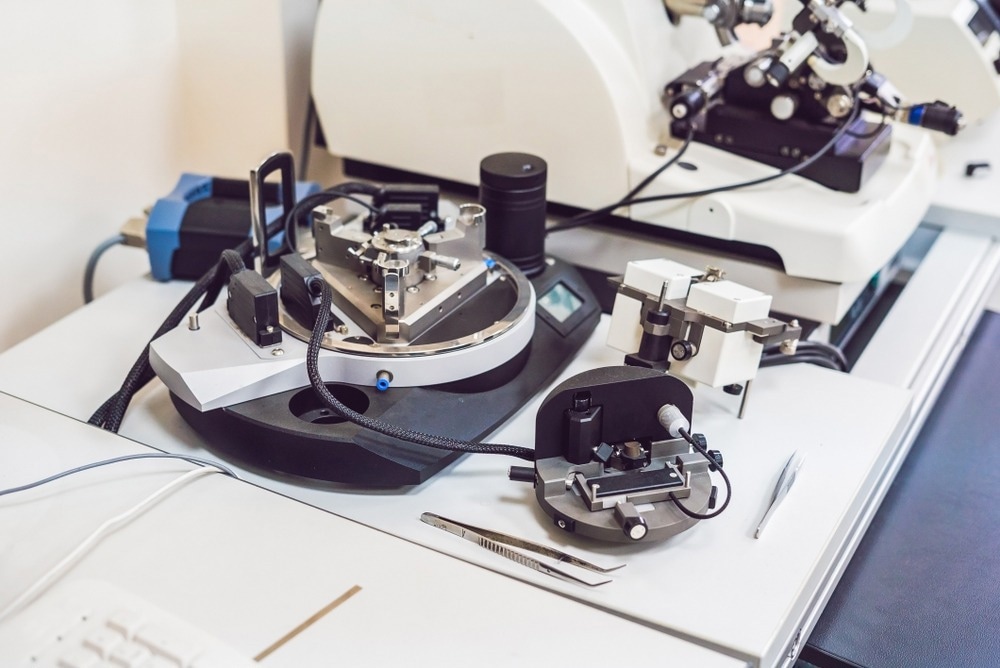Atomic Force Microscopy (AFM) is an imaging technique whose framework is based on scanning force microscopy utilized for imaging various substances such as ceramics, and nanomaterials. A study published in Applied Surface Science focuses on the preparation of lightweight composite structures for nanoindentation and nano-chemical analyzation using gas cluster ion beam (GCIB) etching.

Study: Gas cluster etching for the universal preparation of polymer composites for nano chemical and mechanical analysis with AFM. Image Credit: Elizaveta Galitckaia/Shutterstock.com
AFM Techniques for Analysis of Substances
Enhanced AFM procedures for microstructural and nano-chemical investigation develop a distinctive means of precisely probing the structure and functional composition of a wide variety of material interfaces with spatial and temporal resolution much below standard optical scattering thresholds.
A variety of sub-resonant and resonant microstructural and nanomechanical modeling techniques, notably, offer exceptional sensitivity and accuracy.
Limitations
A certain limitation exists while utilizing AFM to spatially image surfaces. This occurs near the probe radius size (approximately less than 50 nm/pixel). At such precise resolution, the interpreting modifications in mechanical characteristics becomes challenging owing to the confounding effects of exterior topography, subsurface attributes, and adjoining facets.
As a result, the high-resolution AFM method is commonly confined to prototype specimens that are either specifically designed for AFM research or have interfaces that can be effectively produced using a very confined set of procedures.
Why a Surface Preparation Technique is Needed?
The specimen preparation limitation severely restricts the use of high-precision AFM scanning for operationally liable materials and in-situ study of massive polymeric composite materials.
Given these considerations, a specimen preparation process that enables the ubiquitous fabrication of ultra-smooth, damage-free interfaces from functionally viable composites and elements, such as biomaterials, power storage, and photovoltaic devices, is desperately needed. Hard and soft phases are utilized in conjunction during such applications, and nanotechnological property variation can inform macroscopic level functioning and effectiveness.
Gas Cluster Ion Beam Method (GCIB)
One possibility is to employ a gas cluster ion beam for etching (GCIB). A GCIB produces groupings of 100 to 1000 Argon atoms, ionizes the atoms, and then propels them forward towards the exterior of a targeted material. The GCIB's massive clusters spread impacting kinetic energy across a vast region, restricting specimen degradation to a shallow surface region that is then eliminated during etching.
Comparison of Traditional Monoatomic Ion Guns and GCIB
In contrast to GCIB, monoatomic ion systems, which are more typically employed as engraving tools, propel individual Argon ions that infiltrate deeply into a material and produce severe surface defects that are not erased by further etching.
As a consequence, GCIB may erode reactive polymeric substances while leaving a smooth finish, whereas single atom ions can permanently disrupt delicate polymers like PMMA owing to ester bond cleavage.
GCIB guns are frequently used in combination with interface-sensitive chemical analysis methods such as X-ray photoelectron spectroscopy (XPS) or supplementary ion mass spectroscopy (SIMS), which analyze topologically essential chemistry alterations as the substance is scratched away.
A series of trials were used to illustrate GCIB's ability to eliminate material and generate flawless, damage-free composite substrates.
Research Findings
The polymeric overburden material was discovered to be flawless at the starting surface (0 s). Some early work material was detected as low phase characteristics after roughly 15-30 seconds of GCIB etching. After 1 minute of etching, there was an obvious shift from the comparatively characterless overburden layer to the composite material layer.
Before engraving, the first XPS trace mostly caught the C 1s signal from the PS overburden material, with a relatively tiny Si 2p signal reflective of the OCS in the composite layer. The etched and overloaded regions of the PMMA composites were used to acquire AFM-IR spectra.
The AFM-IR data indicates peaks that correlate to both the OCS and the PMMA; however, the relative magnitudes differ in the carved and overburden. The AFM-IR data indicated peaks that correlate to both the OCS and the PMMA; however, the relative amplitudes differ in the carved and overburdened areas.
As the AFM-IR signal intensity is likewise affected by the thermal properties, the observed difference in comparative signal intensity is thought to be caused by AFM-IR being more responsive to PMMA than OCS due to the PMMA's greater coefficient of expansion.
The considerable shift in the spectrum after removing the 50 nm PMMA coating revealed that AFM-IR sensitivity was biased toward near-surface species. In reference to the OCS signal changes, the PMMA spectra revealed no significant difference compared to the carbonyl peak, corroborating the XPS findings that the GCIB did not significantly affect the chemical of the residual PMMA substance.
In summary, the current study revealed a novel route for the nanoscale characterization of polymeric composites utilizing interfacial methods, which is crucial for comprehending structure-property associations in complex material systems.
Disclaimer: The views expressed here are those of the author expressed in their private capacity and do not necessarily represent the views of AZoM.com Limited T/A AZoNetwork the owner and operator of this website. This disclaimer forms part of the Terms and conditions of use of this website.
Source:
Collinson, D. W. et. al. 2022. Gas cluster etching for the universal preparation of polymer composites for nano chemical and mechanical analysis with AFM. Applied Surface Science. 599. 53954. Available at: https://www.sciencedirect.com/science/article/abs/pii/S0169433222014970